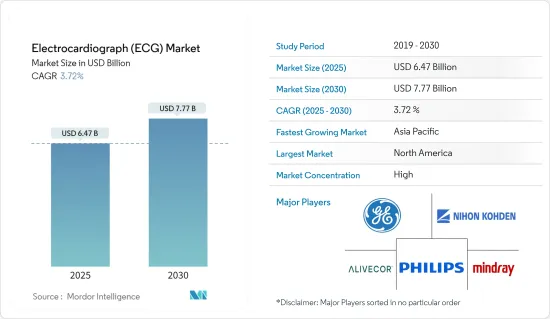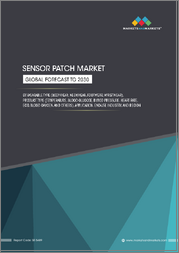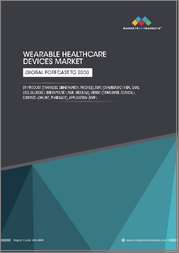
|
시장보고서
상품코드
1686543
심전계(ECG) 시장 : 시장 점유율 분석, 산업 동향 및 통계, 성장 예측(2025-2030년)Electrocardiograph (ECG) - Market Share Analysis, Industry Trends & Statistics, Growth Forecasts (2025 - 2030) |
||||||
심전계 시장 규모는 2025년에 64억 7,000만 달러로 추정되고, 예측 기간인 2025-2030년 CAGR 3.72%로 성장할 전망이며, 2030년에는 77억 7,000만 달러에 달할 것으로 예측됩니다.

COVID-19 팬데믹은 ECG 장비의 생산에 영향을 미쳤습니다. 또한 COVID-19 관련 조치에 의한 선택적 조치의 지연은 특히 2020년 ECG 시장에 악영향을 미쳤습니다. 반면 코로나19는 심혈관계에 악영향을 미쳐 ECG의 이상 소견으로 이어질 수 있습니다. 예를 들어, 2021년 3월에 발표된 「COVID-19의 심전도 소견」이라고 하는 보고서에 의하면, COVID-19는 심혈관계에 악영향을 미치고, 사이토카인스톰, 저산소상해, 전해질 이상, 플라크 파열, 관상축, 미세혈전 외에 내피와 심근의 직접적인 부상으로 인한 비정상 심전도 소견을 유발할 수 있습니다. 코로나19로 인한 심혈관 합병증의 증례 증가는 ECG에 의한 진단검사를 증가시킬 수 있어 ECG 사용량 증가에 도움이 되고 ECG 시장의 성장을 증대시킵니다. 그러나 ECG의 이점은 팬데믹 시 시장 성장에 도움이 됩니다. 예를 들어 '코로나19 환자의 심전도 변화'라는 제목의 연구에 따르면 ECG는 팬데믹 시 시장 성장에 도움을 줍니다. : 2022년 1월 발표된 'A Hospital-based Descriptive Study'에 따르면 코로나19 환자는 허혈 변화, 심박수, 리듬, 전도 장애를 포함한 ECG의 이상을 보였습니다. 심전도는 코로나19 대유행과 제한된 헬스케어 자원에 직면한 가운데 심장장애의 조기 진단 및 관리를 돕기 위해 침대 옆에서 사용할 수 있는 간단하고 비침습적인 검사입니다. 이러한 이점과, 코로나19 유행시의 병원이나 응급 의료에 있어서의 심전도에의 용이한 액세스는, ECG 시장의 성장에 큰 영향을 나타냈습니다.
심혈관 질환의 증례 증가와 고령화 인구 증가로 시장 성장이 예상되고 있습니다. 다양한 연령대에 걸친 심혈관질환 발생률 및 유병률 증가는 주로 스트레스가 많은 노동환경, 앉기 쉬운 라이프스타일, 담배, 알코올, 물질남용의 소비 증가, 노년인구의 증가로 인한 것이며, 이러한 요인들은 본 조사의 예측기간 동안 ECG 시장의 성장에 긍정적인 영향을 줄 것으로 예측되고 있습니다. '심방세동의 세계역학'이라는 제목의 조사연구에 따르면 심방세동의 세계역학은 증가하는 역병과 공중보건의 과제입니다. : 2020년 1월 발표된 'An increasing epidemic and public health challenge'에 따르면 가장 흔한 심장부정맥은 심방세동이며 허혈성 뇌졸중의 주요한 위험인자로 이환율과 사망률뿐만 아니라 막대한 경제적 부담을 야기하고 있습니다. 게다가 같은 출처에 따르면 심방세동은 2050년까지 미국에서 600만-1,200만 명에게 영향을 줄 전망이며, 2060년까지 1,790만 명에게 영향을 줄 것으로 추정되고 있습니다. 이 데이터는 심전도로 진단할 수 있는 심방세동 유병률의 높은 수준을 보여줍니다. 따라서 ECG 시장은 예측 기간에 큰 영향을 줄 것으로 예상됩니다.
또 다른 성장 촉진요인은 원격 모니터링 장비의 사용 증가와 빠른 기술 진보입니다. 예를 들어, 2020년 9월 미국 식품의약국(FDA)은 삼성 심전도(ECG) 모니터링 앱을 승인했습니다. 호환되는 갤럭시 워치에 연결하면 시계의 ECG 모니터가 사용자의 심장 리듬을 모니터링하고 부정맥 징후와 심방 세동(AFib) 징후를 스캔합니다. 게다가 2021년 1월에 발표된 'A Study on Arrhythmia via ECG Signal Classification Using the Convolutional Neural Network(컨벌루션 신경망을 이용한 심전도 신호 분류에 의한 부정맥에 관한 연구)'라는 제목의 연구에서는 머신러닝과 심층 학습 네트워크도 심전도 신호에 기초하여 심장병의 보조 진단에 일반적으로 사용되고 있습니다. 심전도에서 이러한 선진적인 기법은 예측 기간 동안 시장 성장을 보완할 것으로 기대됩니다.
그러나 고가의 장비와 유지보수, 복잡한 상환 정책이 ECG 시장의 성장을 억제하는 요인이 되고 있습니다.
심전계(ECG) 시장 동향
홀터 심전도 시스템은 예측 기간 동안에도 시장의 강력한 성장을 보여줍니다.
진단과 모니터링 측면에서 새로운 세대의 휴대용으로 컴팩트한 홀터 ECG가 특히 재택 건강 분야에서의 채용 확대를 견인하고 있습니다. 홀터 ECG 시스템은 휴대용 심전계(ECG)의 일종입니다. 심장의 전기적 활동을 24시간 이상에 걸쳐 연속적으로 기록합니다. 홀터 ECG의 장점과 그 이용 용이성이 이 부문의 우위성을 높이고 있습니다. 예를 들어 2020년 5월에 발행된 '외부 메모리와 블루투스 연결을 탑재한 저비용 홀터 모니터 설계'라는 제목의 보고서에서는 새로 개발된 ECG 홀터는 심장병을 앓는 사람들을 지원하기 위해 휴대 가능한 치수로 대량생산을 위해 제조 가능한 저비용이라고 기술되어 있습니다. 또, 데이터를 컴퓨터에 송신하기 위한 Bluetooth 트랜스미터도 탑재되어 있습니다. 이러한 새로운 진보와 쉬운 접근성으로 홀터 심전도 시스템은 예측 기간에 있어 보다 우위성을 가지고 있습니다.
또한, 홀터 심전도 장비를 제조하는 기업간의 제휴는 이 부문의 성장을 강화합니다. 예를 들어, 2021년 9월에 아스텔라스 제약, 닛토덴코, 엠하트는 심전도 검사 서비스에 관한 각서를 체결했습니다. 이 각서에 근거해, 아스텔라스 제약, 닛토덴코, M. 하트의 3사는, 닛토덴코가 새로운 일회용 홀터 심전계 'EG 홀터'를 개발 및 제조하는 것을 검토해 갑니다.
홀터 심전계의 기술적 진보의 급속한 페이스 및 각사의 제휴에 의해 홀터 심전계 부문의 장래는 유망하고, 결국 예측 기간에 심전계(ECG) 시장의 성장에 공헌할 것으로 보입니다.
예측기간 동안 심전계(ECG) 시장의 성장을 지배하는 것은 북미
심전계(ECG) 시장에서는 북미가 주도적인 지위를 차지하고 있습니다. 정비된 인프라, 기술적으로 고도의 헬스케어 시스템, 미국의 심혈관 질환의 부담 증가에 힘입은 환자 케어 및 요구에 대한 주목의 고조가, 미국 심전계(ECG) 시장의 성장을 견인할 것으로 기대되고 있습니다. 2021년 4월에 발표된 'The number of older people will hit the US economy'like'brick'-USTrade secretary'라는 제목의 보고서에 따르면 2020년까지 미국 인구의 약 16.5%인 5,400만 명이 65세 이상이 되었습니다. 노인인구의 증가에 따라 심혈관질환 발생률은 높아 심장질환의 적절한 검출 및 진단이 지속적으로 필요합니다. 게다가 2022년 미국심장병학회(American College of Cardiology Foundation)에 따르면 미국에서는 심장판막증(VHD)의 유병률이 상승하고 있으며 매년 500만 명 이상의 미국인이 진단되고 있는 반면 미국에서는 최대 150만 명이 대동맥판막협착증(AS)에 시달리고 있습니다. 이처럼 심장질환 유병률의 증가는 북미 ECG 시장의 성장을 증대시킬 것으로 보입니다.
게다가 이 나라의 주요 시장 기업 중에는 기존 제품에 대항하기 위해 신제품이나 신기술을 개발하고 있는 기업도 있고, 이 시장에서 동향하고 있는 타사의 인수나 제휴를 진행하고 있는 기업도 있습니다. 예를 들어 2022년 6월 미국 식품의약국은 메디칼고리즘사 전문가가 개발한 심전도 웨어러블 유닛 큐패치를 등록했습니다. 이 회사에 따르면 Qpatch는 정확한 심장 부정맥 진단을 얻기 위해 개별 ECG 신호를 측정하기 위한 웨어러블 기기입니다. 또, 2021년 12월, 임프리시티사는, 심는형 루프 레코더(ILR)로부터의 ECG 데이터를 분석하는 새로운 의료 알고리즘에 대해 FDA의 인가를 취득했습니다.
따라서 위의 요인으로 인해 심전계(ECG) 시장은 본 연구의 예측 기간 동안 미국에서 성장할 것으로 예측됩니다.
심전계(ECG) 산업 개요
심전계(ECG) 시장은 세계에 사업을 전개하는 여러 기업이 존재하기 때문에 그 성질은 단편적입니다. 주요 기업은 General Electric Company, Koninklijke Philips N.V., NIHON KOHDEN CORPORATION, Schiller AG, Spacelabs Healthcare, AliveCor Inc, Shenzhen Mindray Bio-Medical Electronics, Hill-Rom Services Inc, BPL Medical Technologies, ACS Diagnostics, Allengers 등이 있습니다.
기타 혜택 :
- 엑셀 형식 시장 예측(ME) 시트
- 3개월간의 애널리스트 서포트
목차
제1장 서론
- 조사의 전제조건 및 시장 정의
- 조사 범위
제2장 조사 방법
제3장 주요 요약
제4장 시장 역학
- 시장 개요
- 시장 성장 촉진요인
- 심혈관 질환 환자 증가
- 심장질환의 위험이 높은 고령화 인구 증가
- 원격 감시 장치의 이용 증가
- 급속한 기술 진보
- 시장 성장 억제요인
- 비싼 장비 및 유지 보수
- 복잡한 상환정책
- Porter's Five Forces 분석
- 신규 참가업체의 위협
- 구매자 및 소비자의 협상력
- 공급기업의 협상력
- 대체품의 위협
- 경쟁 기업간 경쟁 관계의 강도
제5장 시장 세분화
- 제품별
- 휴식시 심전도 시스템
- 스트레스 ECG 시스템
- 홀터 심전도 시스템
- 이벤트 레코더
- 기타
- 기술별
- 휴대용 ECG 시스템
- 무선 ECG 시스템
- 리드 유형별
- 싱글 리드 ECG
- 3-6 리드 심전도
- 12 리드 심전계
- 최종 사용자별
- 재택 사용자
- 병원
- 기타 최종 사용자
- 지역별
- 북미
- 미국
- 캐나다
- 멕시코
- 유럽
- 독일
- 영국
- 프랑스
- 이탈리아
- 스페인
- 기타 유럽
- 아시아태평양
- 중국
- 일본
- 인도
- 호주
- 한국
- 기타 아시아태평양
- 중동 및 아프리카
- GCC
- 남아프리카
- 기타 중동 및 아프리카
- 남미
- 브라질
- 아르헨티나
- 기타 남미
- 북미
제6장 경쟁 구도
- 기업 프로파일
- General Electric Company
- Koninklijke Philips NV
- NIHON KOHDEN CORPORATION
- Schiller AG
- Spacelabs Healthcare
- AliveCor, Inc.
- Shenzhen Mindray Bio-Medical Electronics Co., Ltd.
- Hill-Rom Services, Inc.
- BPL Medical Technologies
- ACS Diagnostics
- Allengers
제7장 시장 기회 및 향후 동향
AJY 25.04.29The Electrocardiograph Market size is estimated at USD 6.47 billion in 2025, and is expected to reach USD 7.77 billion by 2030, at a CAGR of 3.72% during the forecast period (2025-2030).

The COVID-19 pandemic impacted the production of ECG devices. Furthermore, the delay of elective procedures due to COVID-19-related measures had adversely affected the ECG market, especially in 2020. On the other hand, COVID-19 can negatively impact the cardiovascular system and lead to abnormal ECG findings. For instance, according to the report titled 'Electrocardiographic manifestations of COVID-19' published in March 2021, COVID-19 can negatively impact the cardiovascular system and lead to abnormal ECG findings, which may be due to cytokine storm, hypoxic injury, electrolyte abnormalities, plaque rupture, coronary spasm, microthrombi, as well as direct endothelial or myocardial injury. This increase in the cases of cardiovascular complications due to COVID-19 may increase the diagnostic testing with ECG, which helps in the increased usage of ECG and augment the growth of the ECG market. However, the benefits of ECG help in the growth of the market during the pandemic. For instance, according to the study titled 'Electrocardiographic Changes in COVID-19 Patients: A Hospital-based Descriptive Study' published in January 2022, Patients with COVID-19 showed anomalies in their ECGs including ischemia alterations, rate, rhythm, and conduction problems. ECG is a straightforward, noninvasive test that can be used at the bedside to aid in the early diagnosis and management of cardiac damage in the face of the COVID-19 pandemic and limited healthcare resources. These advantages and easy access to ECG in hospitals and emergency care during COVID-19 showed a significant impact on the growth of the ECG market in the COVID-19 pandemic.
The market is expected to grow due to the increasing cases of cardiovascular diseases and the rising aging population. The increase in the incidence and prevalence of cardiovascular diseases across different age groups is primarily due to stressful work conditions, sedentary lifestyles, growing consumption of tobacco, alcohol, and substance abuse, and the growing geriatric population, and these factors are anticipated to have a positive impact on the growth of the ECG market during the forecast period of the study. According to the research study titled 'Global epidemiology of atrial fibrillation: An increasing epidemic and public health challenge' published in January 2020, the most common cardiac arrhythmia is atrial fibrillation, which is a major risk factor for ischemic stroke and causes an enormous economic burden as well as morbidity and mortality. Further, as per the same source, it is estimated that atrial fibrillation would affect 6-12 million people in the United States by 2050, while it will affect 17.9 million people by 2060. This data shows a significant prevalence of atrial fibrillation which can be diagnosed using ECG. Thus, the ECG market is anticipated to have a significant impact on the forecast period.
Another growth-driven factor is increased usage of remote monitoring devices and rapid technology advancements. For instance, in September 2020, the United States Food and Drug Administration (FDA) approved Samsung's electrocardiogram (ECG) monitoring app, when connected to a compatible Galaxy watch, the ECG monitor in the watch monitors a user's heart rhythm and scan for signs of irregularities or indications of atrial fibrillation (AFib). Furthermore, in a study titled 'A Study on Arrhythmia via ECG Signal Classification Using the Convolutional Neural Network', published in January 2021, machine learning and deep learning network have also been commonly used in the assisted diagnosis of heart disease based on ECG signals. These advanced methods in the ECG are expected to complement the growth of the market over the forecast period.
However, the expensive instrumentation and maintenance, along with complex reimbursement policies act as the factors restraining the growth of the ECG market.
Electrocardiograph (ECG) Market Trends
Holter ECG Systems will Continue to Demonstrate Strong Growth in the Market During the Forecast Period
On the diagnostic and monitoring front, a new generation of portable and compact Holter ECGs is driving its greater adoption, especially in the home healthcare segment. The Holter ECG system is a type of portable electrocardiogram (ECG). It records the electrical activity of the heart continuously over 24 hours or longer. The advantages of the Holter ECG and its accessibility of it make the segment dominant. For instance, the report titled 'A low-cost Holter monitor design equipped with external memory and Bluetooth connection' published in May 2020, stated that the newly developed ECG Holter is portable in dimension and low cost to be fabricated for mass production to help people with heart disease. The design was also equipped with a Bluetooth transmitter to transmit the data to the computer. These new advancements and easy accessibility make the Holter ECG system more dominant in the forecast period.
Additionally, the collaborations between the companies that manufacture the Holter ECG devices will augment the growth of this segment. For instance, in September 2021, Astellas Pharma, Nitto Denko Corporation, and M. Heart Co., Ltd concluded a memorandum of understanding concerning an ECG testing service. Based on this memorandum of understanding, Astellas, Nitto, and M. Heart will continue to look into Nitto developing and manufacturing the 'EG Holter' a novel disposable Holter ECG device.
With the rapid pace of technological advancements in Holter ECG and companies' collaboration, the future of the Holter ECG segment looks promising, which ultimately help in the growth of the electrocardiograph (ECG) market in the forecast period.
North America to Dominate the Growth of the Electrocardiograph (ECG) Market During the Forecast Period
North America holds the leading position in the electrocardiograph (ECG) market. The rising focus on patient care and needs, supported by the well-developed infrastructure, technologically advanced healthcare system, and the increasing burden of cardiovascular diseases in the United States are expected to drive the growth of the electrocardiograph (ECG) market in the United States. According to the report titled "The number of older people will hit the US economy 'like a' brick '- US trade secretary", published in April 2021, about 16.5% of the United States population, or 54 million, were over the age of 65 by 2020. As the number of old age population increases, the incidence of cardiovascular diseases is high and there is a continuous need for the proper detection and diagnosis of cardiac diseases, hence is expected to show growth of ECG over the forecast period. Additionally, as per the 2022 American College of Cardiology Foundation, the prevalence of valvular heart diseases (VHD) is rising in the United States, with more than 5 million Americans diagnosed each year, while up to 1.5 million people suffer from aortic stenosis (AS) in the United States. Thus, an increase in the prevalence of cardiac diseases will augment the growth of the ECG market in North America.
Additionally, a few of the key market players in the country are developing novel products and technologies to compete with the existing products, while others are acquiring and partnering with other companies trending in the market. For instance, in June 2022, the United States Food and Drug Administration registered Qpatch, an ECG wearable unit developed by experts from Medicalgorithmics. As per the company, Qpatch is a wearable device for measuring individual ECG signals to obtain an accurate cardiac arrhythmia diagnosis. Also, in December 2021, Implicity received FDA clearance for a novel medical algorithm that analyses ECG data from Implantable Loop Recorders (ILRs).
Therefore, due to the above-mentioned factors, the electrocardiograph (ECG) market is expected to grow in the United States over the forecast period of the study.
Electrocardiograph (ECG) Industry Overview
The electrocardiograph (ECG) market is fragmented in nature due to the presence of several companies operating globally. The major players include General Electric Company, Koninklijke Philips N.V., NIHON KOHDEN CORPORATION, Schiller AG, Spacelabs Healthcare, AliveCor, Inc., Shenzhen Mindray Bio-Medical Electronics Co., Ltd., Hill-Rom Services, Inc., BPL Medical Technologies, ACS Diagnostics, and Allengers.
Additional Benefits:
- The market estimate (ME) sheet in Excel format
- 3 months of analyst support
TABLE OF CONTENTS
1 INTRODUCTION
- 1.1 Study Assumptions and Market Definition
- 1.2 Scope of the Study
2 RESEARCH METHODOLOGY
3 EXECUTIVE SUMMARY
4 MARKET DYNAMICS
- 4.1 Market Overview
- 4.2 Market Drivers
- 4.2.1 Increasing Cases of Cardiovascular Diseases
- 4.2.2 Rising Aging Population Has High Risk of Cardiac Disease
- 4.2.3 Increasing Usage of Remote Monitoring Device
- 4.2.4 Rapid Technological Advancements
- 4.3 Market Restraints
- 4.3.1 Expensive Instrument and Maintenance
- 4.3.2 Complex Reimbursement Policies
- 4.4 Porter's Five Force Analysis
- 4.4.1 Threat of New Entrants
- 4.4.2 Bargaining Power of Buyers/Consumers
- 4.4.3 Bargaining Power of Suppliers
- 4.4.4 Threat of Substitute Products
- 4.4.5 Intensity of Competitive Rivalry
5 MARKET SEGMENTATION (Market Size by Value - USD million)
- 5.1 By Product
- 5.1.1 Rest ECG Systems
- 5.1.2 Stress ECG Systems
- 5.1.3 Holter ECG Systems
- 5.1.4 Event Recorders
- 5.1.5 Others
- 5.2 By Technology
- 5.2.1 Portable ECG Systems
- 5.2.2 Wireless ECG Systems
- 5.3 By Lead Type
- 5.3.1 Single Lead ECG
- 5.3.2 3-6 Lead ECG
- 5.3.3 12 Lead ECG
- 5.4 By End Users
- 5.4.1 Home-Based Users
- 5.4.2 Hospitals
- 5.4.3 Other End Users
- 5.5 Geography
- 5.5.1 North America
- 5.5.1.1 United States
- 5.5.1.2 Canada
- 5.5.1.3 Mexico
- 5.5.2 Europe
- 5.5.2.1 Germany
- 5.5.2.2 United Kingdom
- 5.5.2.3 France
- 5.5.2.4 Italy
- 5.5.2.5 Spain
- 5.5.2.6 Rest of Europe
- 5.5.3 Asia-Pacific
- 5.5.3.1 China
- 5.5.3.2 Japan
- 5.5.3.3 India
- 5.5.3.4 Australia
- 5.5.3.5 South Korea
- 5.5.3.6 Rest of Asia-Pacific
- 5.5.4 Middle East and Africa
- 5.5.4.1 GCC
- 5.5.4.2 South Africa
- 5.5.4.3 Rest of Middle East and Africa
- 5.5.5 South America
- 5.5.5.1 Brazil
- 5.5.5.2 Argentina
- 5.5.5.3 Rest of South America
- 5.5.1 North America
6 COMPETITIVE LANDSCAPE
- 6.1 Company Profiles
- 6.1.1 General Electric Company
- 6.1.2 Koninklijke Philips N.V.
- 6.1.3 NIHON KOHDEN CORPORATION
- 6.1.4 Schiller AG
- 6.1.5 Spacelabs Healthcare
- 6.1.6 AliveCor, Inc.
- 6.1.7 Shenzhen Mindray Bio-Medical Electronics Co., Ltd.
- 6.1.8 Hill-Rom Services, Inc.
- 6.1.9 BPL Medical Technologies
- 6.1.10 ACS Diagnostics
- 6.1.11 Allengers

















